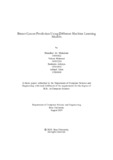| dc.contributor.advisor | Alam, Md. Ashraful | |
| dc.contributor.author | Khandker Al- Muhaimin | |
| dc.contributor.author | Tahsan Mahmud | |
| dc.contributor.author | Sudeepta Acharya | |
| dc.contributor.author | Ashiqul Islam | |
| dc.date.accessioned | 2020-02-18T06:11:12Z | |
| dc.date.available | 2020-02-18T06:11:12Z | |
| dc.date.copyright | 2019 | |
| dc.date.issued | 2019-08 | |
| dc.identifier.other | ID 14101022 | |
| dc.identifier.other | ID 14101224 | |
| dc.identifier.other | ID 14101032 | |
| dc.identifier.other | ID 13301010 | |
| dc.identifier.uri | http://hdl.handle.net/10361/13780 | |
| dc.description | This thesis is submitted in partial fulfillment of the requirements for the degree of Bachelor of Science in Computer Science, 2019. | en_US |
| dc.description | Cataloged from PDF version of thesis. | |
| dc.description | Includes bibliographical references (pages 32-33). | |
| dc.description.abstract | Breast cancer is often the most lethal diseases with a large mortality rate especially among women. Despite the severe effect of the disease, it is possible to pinpoint the genre of breast cancer using diff t machine learning algorithms. However, many of these algorithms perform differenttly depending on their types and complexities. In our work, we have analyzed and compared the classification results of various ma- chine learning models and fi out the best model to classify between diff t types of breast cancers. We have used Logistic Regression, SVM, Random Forest, AdaBoost Tree, NaA˜ ve Bayes, K neighbor classifier, Decision Tree and Gaussian Process classifiers for our comparative study. Additionally, we applied dimensional- ity reduction in order to simplify our dataset from 30 features to 2 features so that the computation time can be reduced. Our task is to critically analysis different data and to classify them with respect to the efficacy of each algorithm in terms of accuracy, precision, recall and F1 Score. Without dimensionality reduction, our best accuracy was 97.36 percent which was found using SVM. Then again, with dimensionality reduction, the prime accurate result was 98.24 percent which was achieved by SVM and the computation time also decreased. | en_US |
| dc.description.statementofresponsibility | Khandker Al- Muhaimin | |
| dc.description.statementofresponsibility | Tahsan Mahmud | |
| dc.description.statementofresponsibility | Sudeepta Acharya | |
| dc.description.statementofresponsibility | Ashiqul Islam | |
| dc.format.extent | 33 pages | |
| dc.language.iso | en | en_US |
| dc.publisher | Brac University | en_US |
| dc.rights | Brac University theses are protected by copyright. They may be viewed from this source for any purpose, but reproduction or distribution in any format is prohibited without written permission. | |
| dc.subject | Supervised learning | en_US |
| dc.subject | Comparative study | en_US |
| dc.subject | Breast cancer | en_US |
| dc.subject | Cancer prediction | en_US |
| dc.subject | Adaboost classifier | en_US |
| dc.subject | PCA | en_US |
| dc.subject.lcsh | Image processing | |
| dc.subject.lcsh | Machine learning | |
| dc.title | Breast cancer prediction using different machine learning models | en_US |
| dc.type | Thesis | en_US |
| dc.contributor.department | Department of Computer Science and Engineering, Brac University | |
| dc.description.degree | B. Computer Science | |

